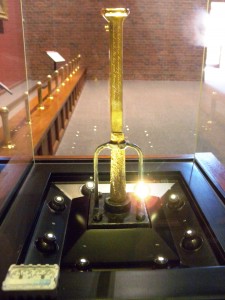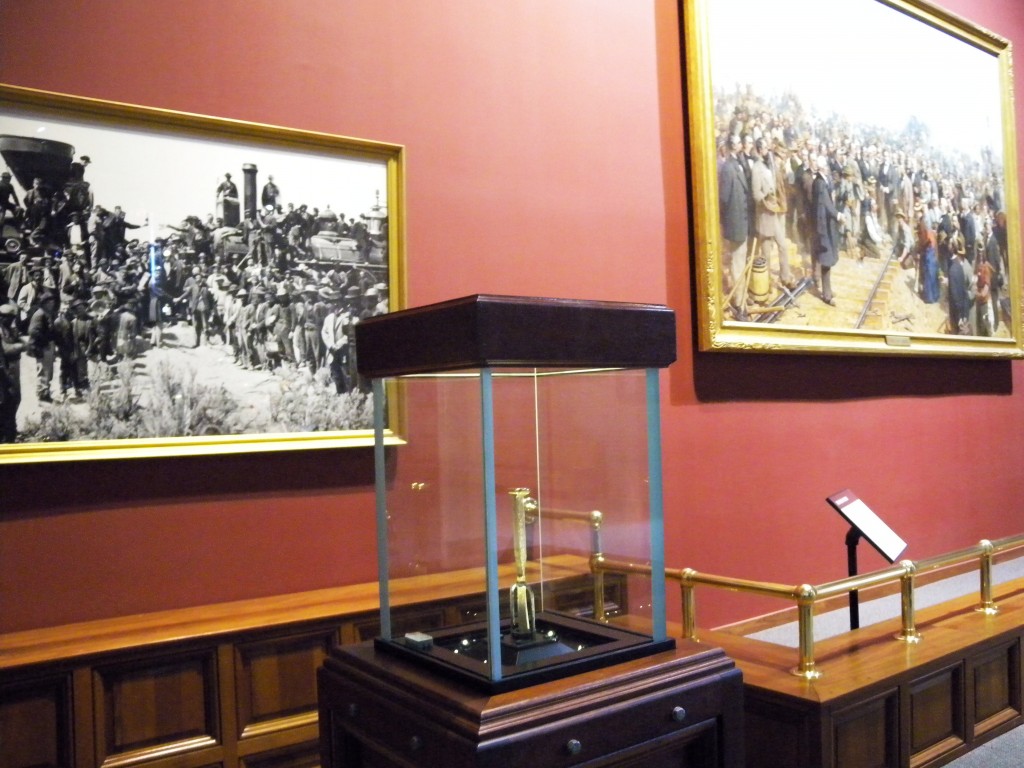» posted on Friday, April 13th, 2012 by Linda Lou Burton
Facts and Fictions
 Linda Burton posting from Sacramento, California – Tucked away in a corner of the California State Railroad Museum in a temperature-controlled case is the golden “Lost Spike.” Hanging on the wall near the spike are a portrait and a photograph – two depictions of the famous “moment in time” when the Union Pacific and Central Pacific railroads met in Promontory, Utah, thus connecting by rail the eastern and western states. The date was May 10, 1869. Why was the golden spike lost? And why do the portrait and the photograph present such a different atmosphere of the occasion? The visitor is invited to study, and ponder.
Linda Burton posting from Sacramento, California – Tucked away in a corner of the California State Railroad Museum in a temperature-controlled case is the golden “Lost Spike.” Hanging on the wall near the spike are a portrait and a photograph – two depictions of the famous “moment in time” when the Union Pacific and Central Pacific railroads met in Promontory, Utah, thus connecting by rail the eastern and western states. The date was May 10, 1869. Why was the golden spike lost? And why do the portrait and the photograph present such a different atmosphere of the occasion? The visitor is invited to study, and ponder.
The photograph, by A J Russell (1830-1902), has a look of exuberance; people crowding one against the other in a crush; climbing on the locomotives which are almost nose-to-nose; jubilation in the air with champagne toasts. Officially named East and West Shaking Hands at Laying of Last Rail the photograph is more commonly known as The Champagne Photo; champagne did flow and engineers George Booth and Sam Bradford each broke a bottle upon the other’s locomotive; Union Pacific’s No 119 and Central Pacific’s Jupiter. Railroad officials retired to their cars, leaving the engineers and workmen to celebrate.
The portrait, by Thomas Hill (1829-1908), named The Last Spike, is more symbolic, showing mountains far distant to the east; a stagecoach, now out of date; a keg of spikes. There are about 400 people shown on the canvas; 70 of them are portraits within the portrait, grouped in order of prominence. Hill even included individuals responsible for the railroad’s construction who were not present – Theodore Judah died in 1863, Charles Crocker was busy in Sacramento, and Lewis Clement was in Washington dealing with Congress. Hill’s painting shows a serious moment – the clergyman just finishing his prayer.
Historic records tell us that about 1,000 people participated in the celebration that day; besides politicians and railroad officials there was a contingent of Chinese railroad workers, five companies of soldiers from the 21st US Infantry Regiment, and members of the public, including a small number of women and children. Andrew Russell was hired by Union Pacific to photograph the railroad’s construction; Thomas Hill was never paid for his work, one of the most ambitious portraitures ever attempted, which was completed in 1881.
The lost spike? It was part of the original order for the last spike, a commemorative in gold to be used during the ceremonies of May 10 and the idea of David Hewes, who commissioned the casting. One spike was used – The Last Spike; it has been on display at Stanford University since 1892. The Hewes family kept the other until 2006, when it was put on permanent display at the California State Railroad Museum.
Facts and fictions; world-changing achievements intertwined with egos; there’s a lot of history tucked into that little corner of the museum.
http://www.csrmf.org/events-exhibits/whats-new/see-the-golden-lost-spike-at-the-museum

